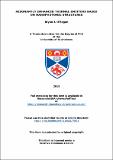Files in this item
Resonantly enhanced thermal emitters based on nanophotonic structures
Item metadata
| dc.contributor.advisor | Krauss, Thomas F. | |
| dc.contributor.author | O'Regan, Bryan J. | |
| dc.coverage.spatial | xiv, 143 p. | en_US |
| dc.date.accessioned | 2015-11-17T11:43:26Z | |
| dc.date.available | 2015-11-17T11:43:26Z | |
| dc.date.issued | 2015-11-30 | |
| dc.identifier | uk.bl.ethos.675220 | |
| dc.identifier.uri | https://hdl.handle.net/10023/7801 | |
| dc.description.abstract | The manipulation of photons, especially the control of spontaneous emission, has become a core area of photonics research in the 21st century. One of the key challenges is the control of the broadband emission profile of thermal emitters. Recently, attention has focused on resonant nanophotonic structures to control the thermal emission with most of the work concentrating on the mid-infrared wavelength range and/or based on metallic nanostructures. However, the realisation of a high temperature, single wavelength, narrowband and efficient thermal source, remains a challenge. In this project, four individual nanophotonic resonant structures are presented for the control of thermal emission, all operating in the near-infrared (≈ 1.5 μm) wavelength range. The work is split over two different emission materials; gold and doped silicon. While I present two successful designs of narrowband thermal emitters from gold, the main backbone of the research is concentrated on doped silicon as the emission material. By combining the weak broadband absorption of doped silicon with a photonic crystal resonator, resonantly enhanced narrowband absorption is achieved. Using Kirchhoff's law of thermal radiation which equates the absorptivity and emissivity, narrowband absorption leads to narrowband emission, which is the underlying principle used throughout the work presented in this thesis to achieve narrowband thermal emission. One common oversight in many of the presented thermal emitter designs is the angular emission dependence, i.e. how the emission wavelength behaves away from surface normal. Typically, since the majority of the devices are based on periodic structures, the resonant emission wavelength changes with emission angle, which is not ideal. Here, the angular sensitivity is considered and addressed, by constructing a device that is based on localised confined resonances and not on propagating resonances, it is possible to achieve a truly monochromatic source i.e. one with the same emission wavelength in all directions, all the way up to an angle of 90°. Finally, the devices presented here demonstrate that weak absorption together with photonic resonances can be used as a wavelength-selection mechanism for thermal emitters, both for the enhancement and the suppression of emission away from the resonant wavelength. | en_US |
| dc.language.iso | en | en_US |
| dc.publisher | University of St Andrews | |
| dc.rights | Creative Commons Attribution-NonCommercial-NoDerivatives 4.0 International | |
| dc.rights.uri | http://creativecommons.org/licenses/by-nc-nd/4.0/ | |
| dc.subject | Narrowband thermal emitter | en_US |
| dc.subject | 2D photonic crystal | en_US |
| dc.subject | Doped silicon | en_US |
| dc.subject | Flat dispersion | en_US |
| dc.subject | Near-infrared | en_US |
| dc.subject.lcc | TA1570.O8 | |
| dc.subject.lcsh | Infrared sources | en_US |
| dc.subject.lcsh | Nanophotonics | en_US |
| dc.title | Resonantly enhanced thermal emitters based on nanophotonic structures | en_US |
| dc.type | Thesis | en_US |
| dc.type.qualificationlevel | Doctoral | en_US |
| dc.type.qualificationname | PhD Doctor of Philosophy | en_US |
| dc.publisher.institution | The University of St Andrews | en_US |
This item appears in the following Collection(s)
Except where otherwise noted within the work, this item's licence for re-use is described as Creative Commons Attribution-NonCommercial-NoDerivatives 4.0 International
Items in the St Andrews Research Repository are protected by copyright, with all rights reserved, unless otherwise indicated.


